
在2021年底景德镇三宝国际陶艺村创始人、景德镇陶瓷大学特聘教授李见深教授作为项目总策划邀请建筑师来痘姆陶厂现场踏勘时,陶厂内正在进行全方位的升级建设。我们领到的设计任务包括其中两座建筑的新建和改造——其一非遗客厅建筑已经开挖地基,因此建筑外轮廓及结构位置已确定;其二覆盖石棉瓦屋顶的龙窑则亟待更新,以满足窑篷建筑的坚固性和美观性要求,并适应其新功能。
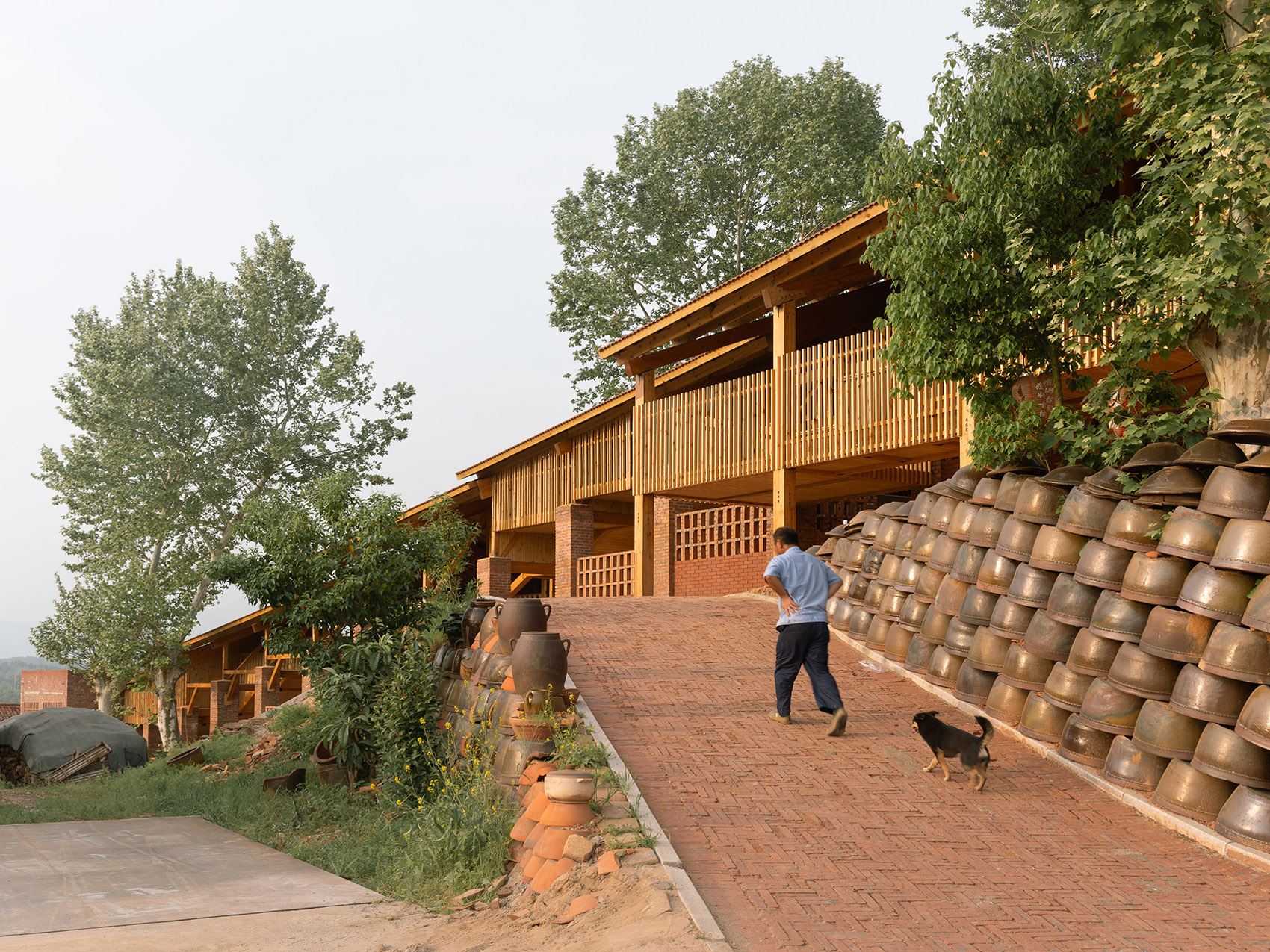
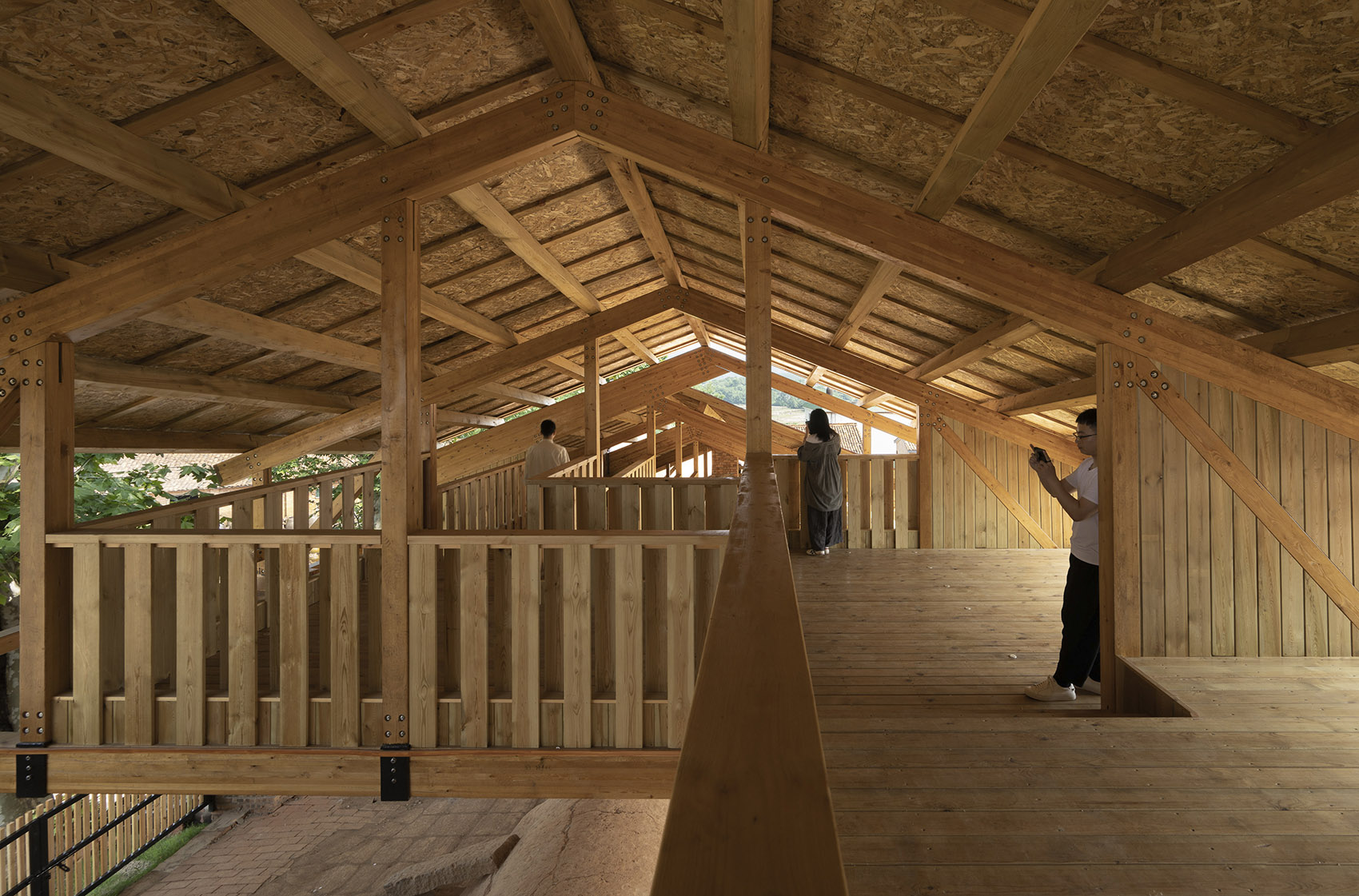

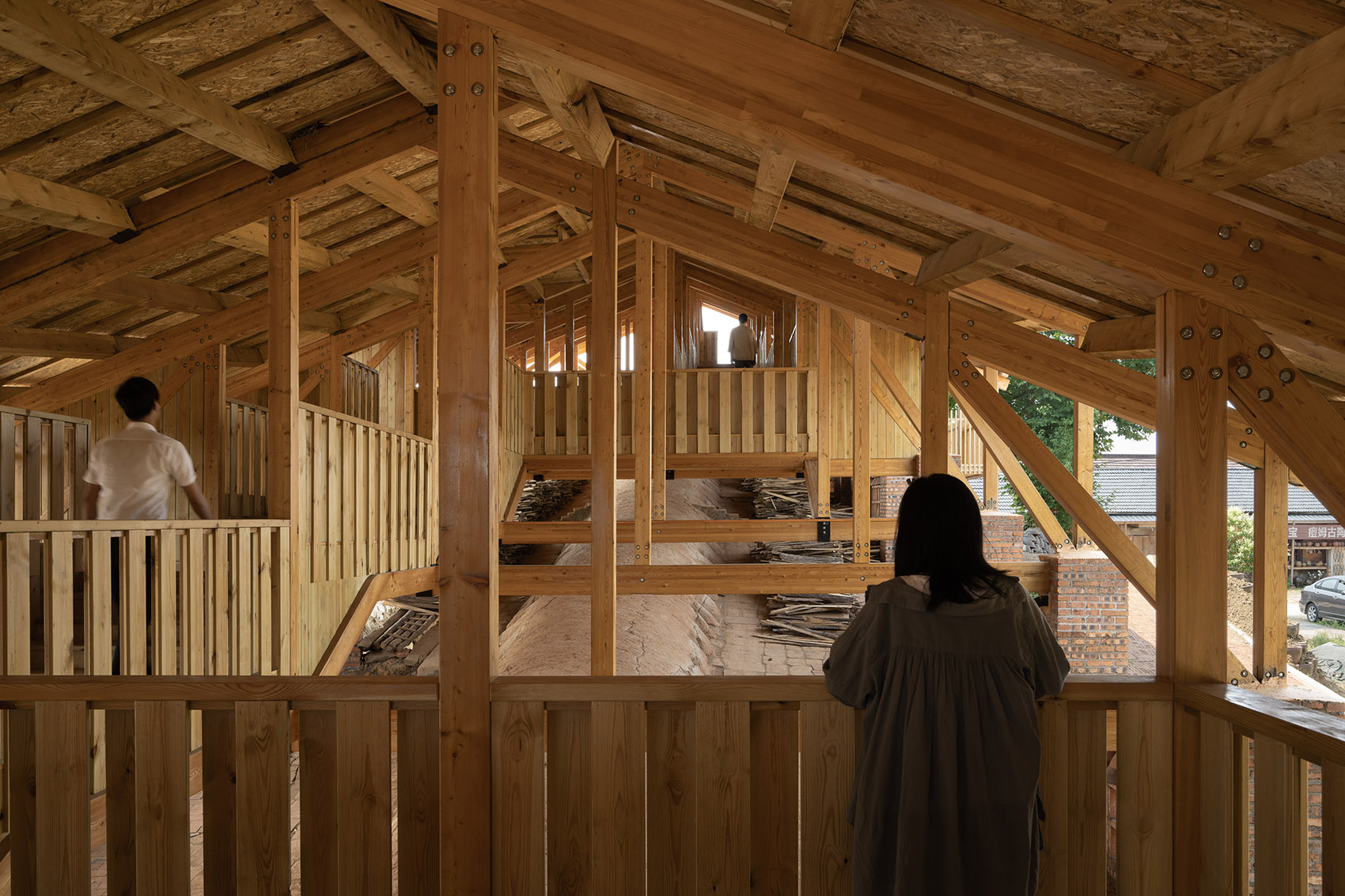




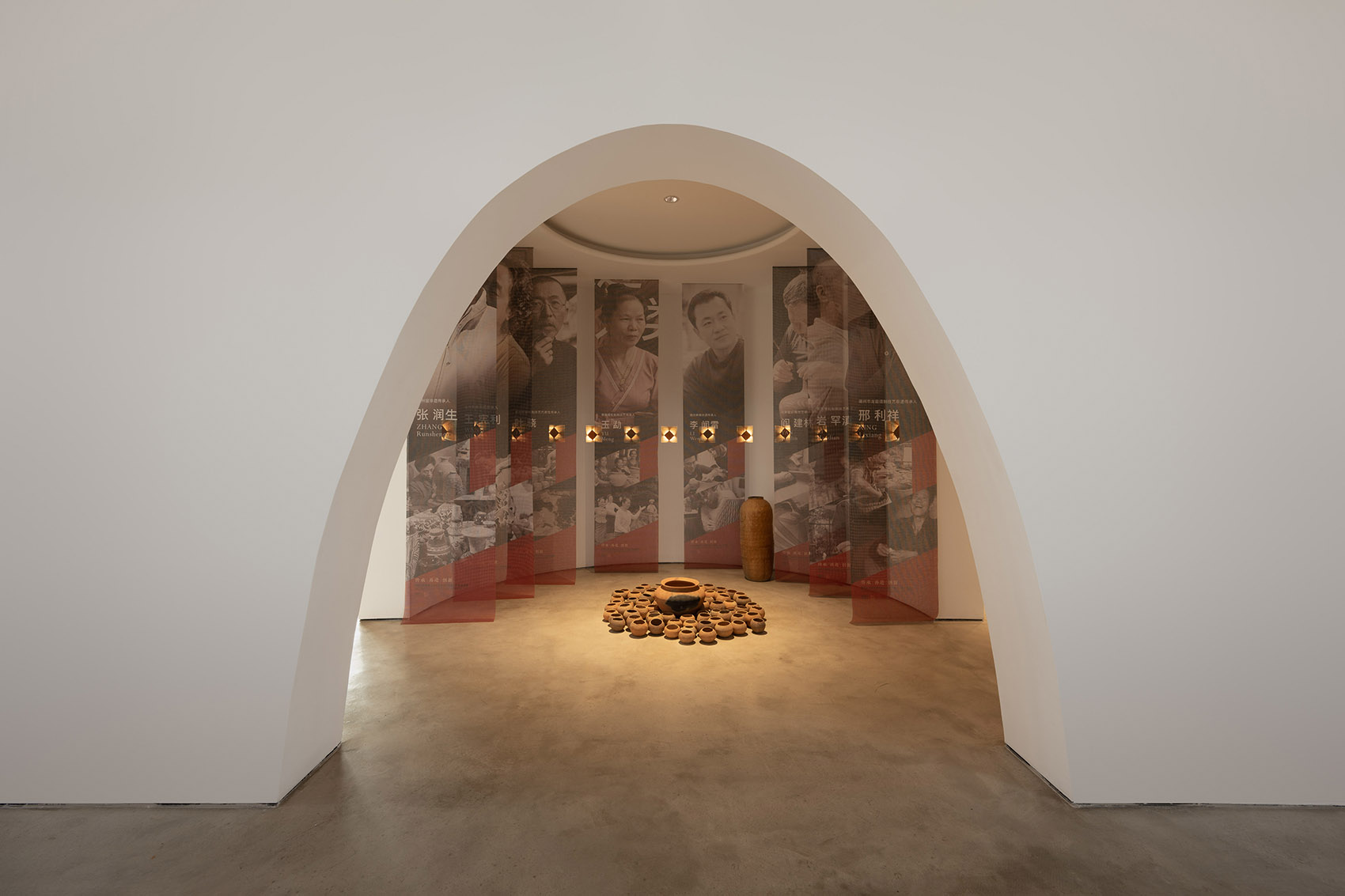
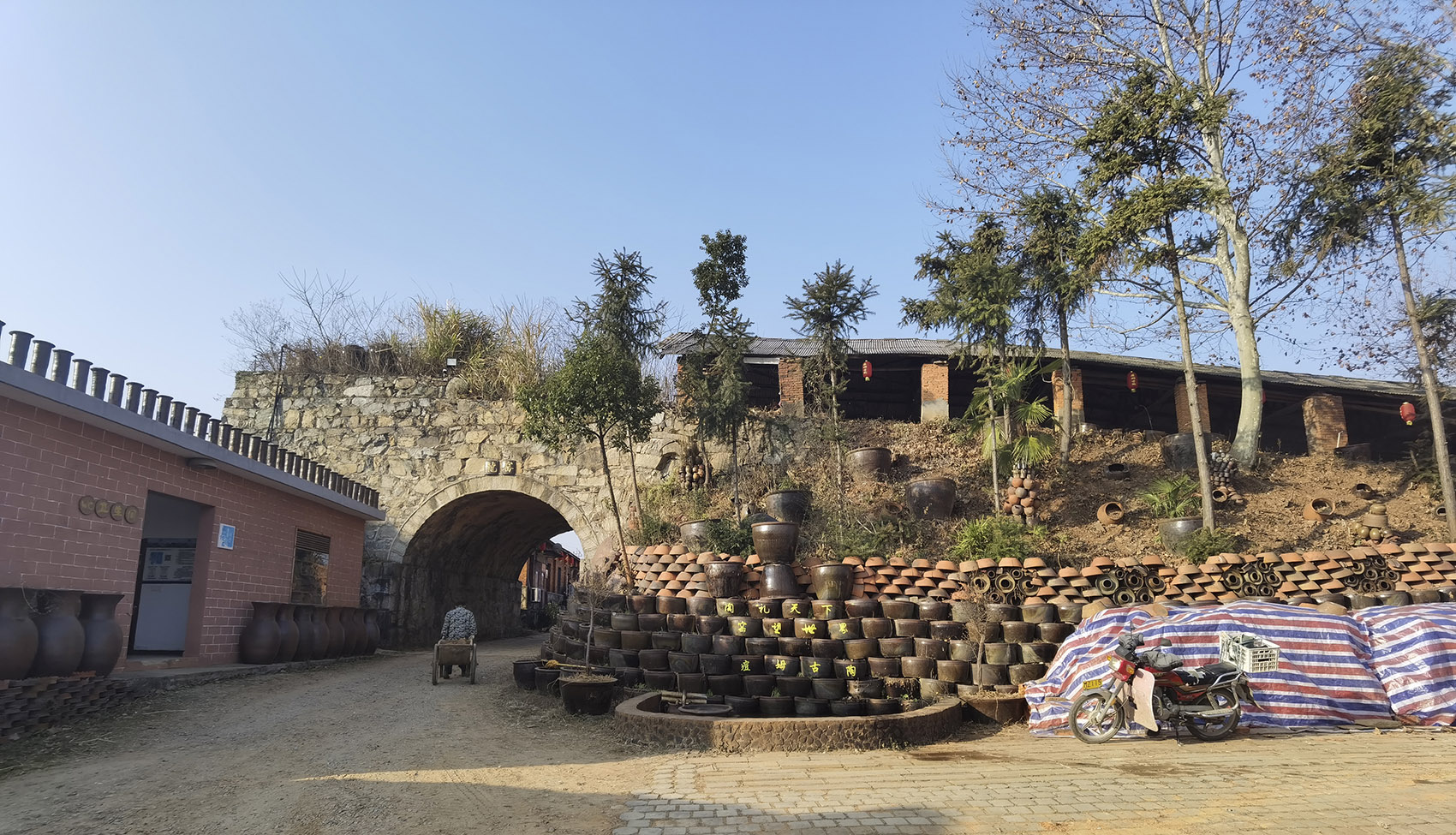
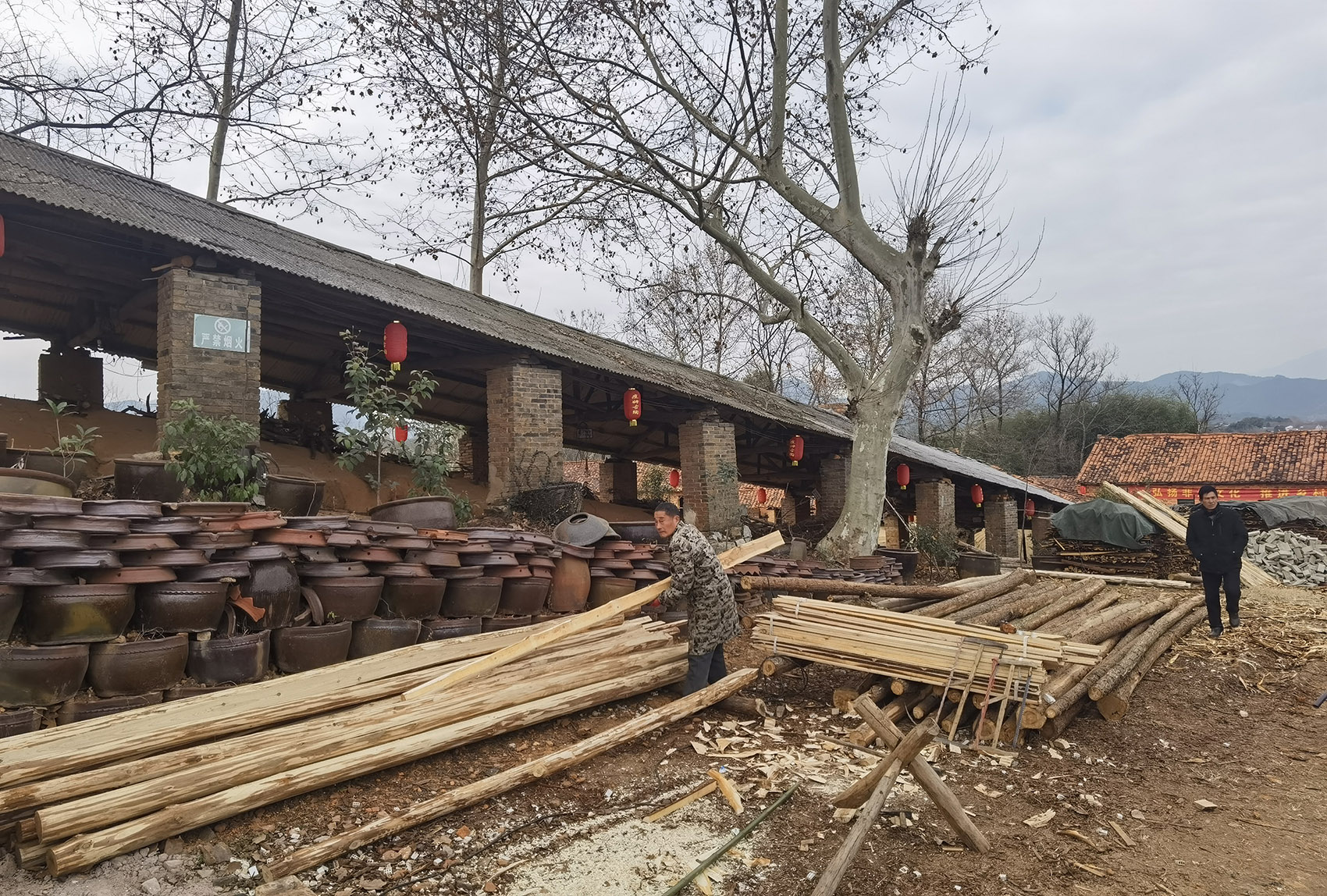

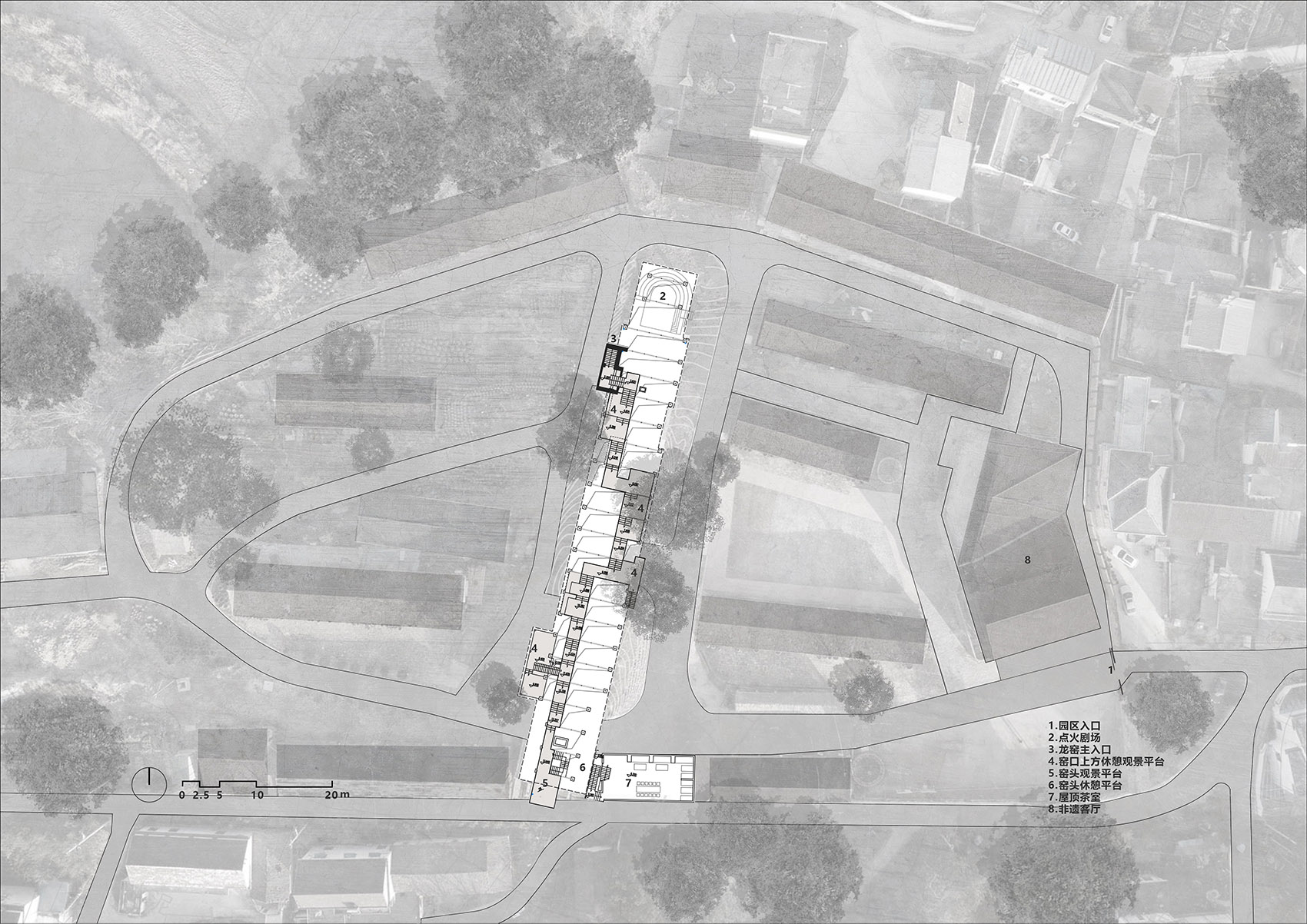
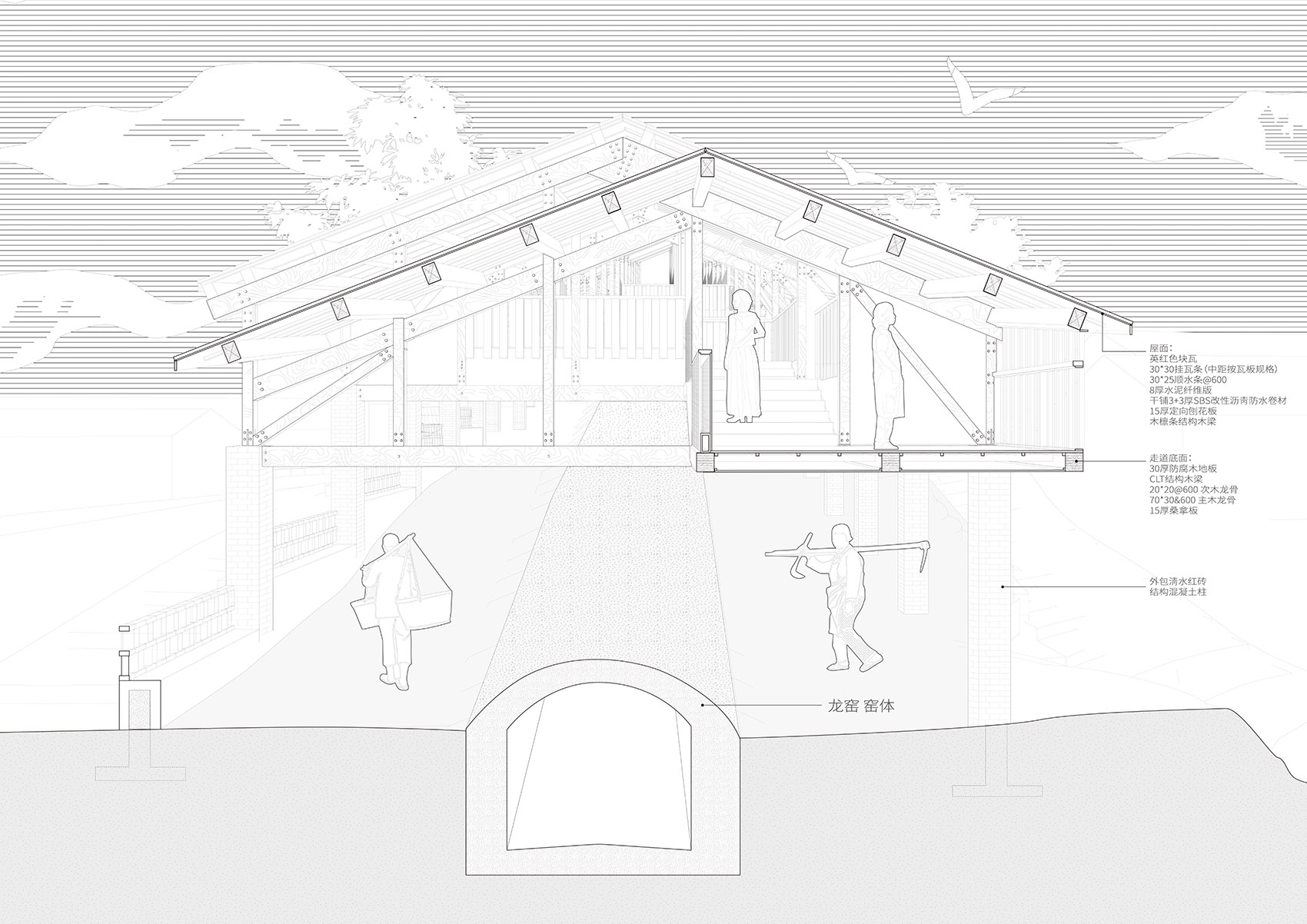
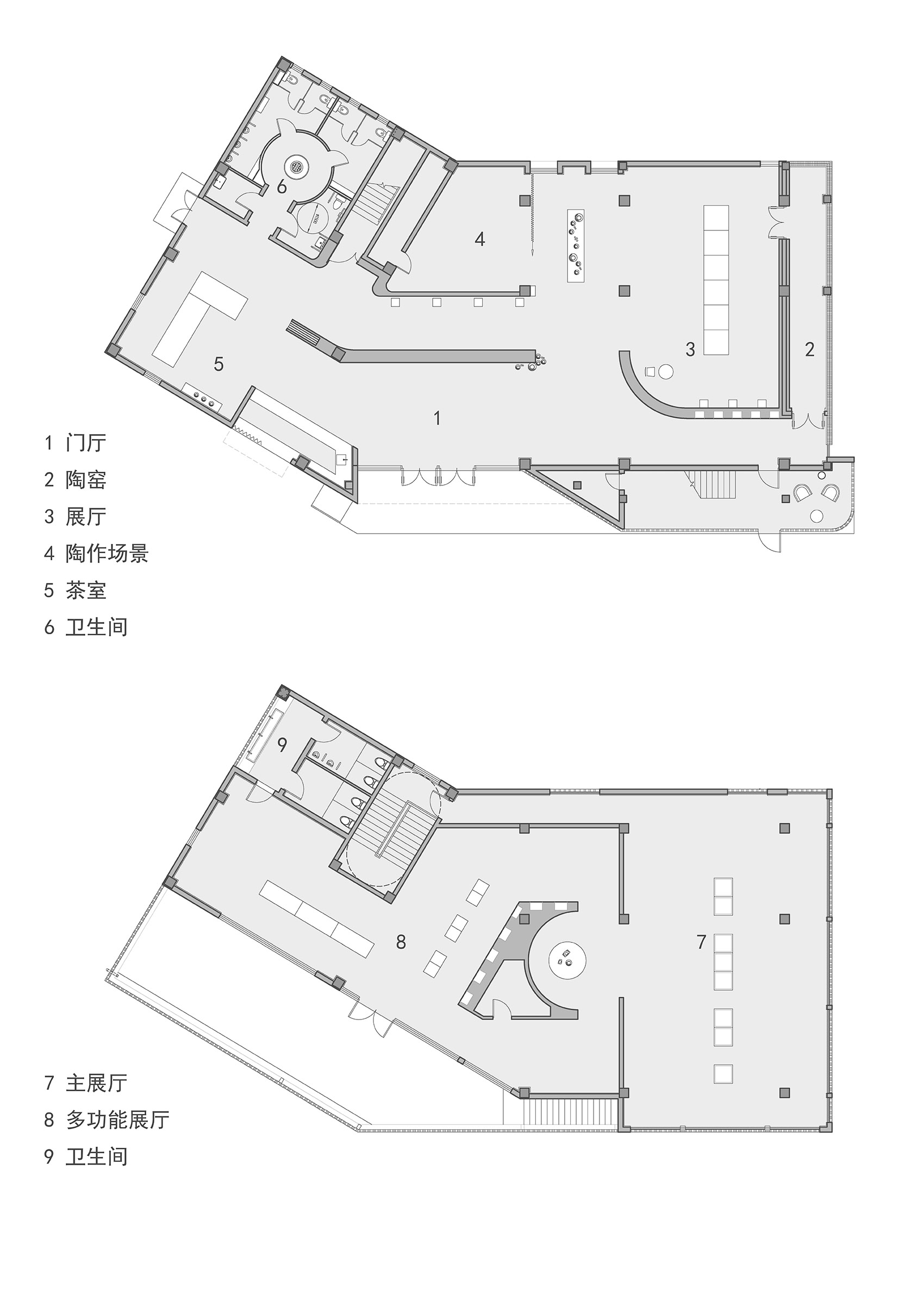
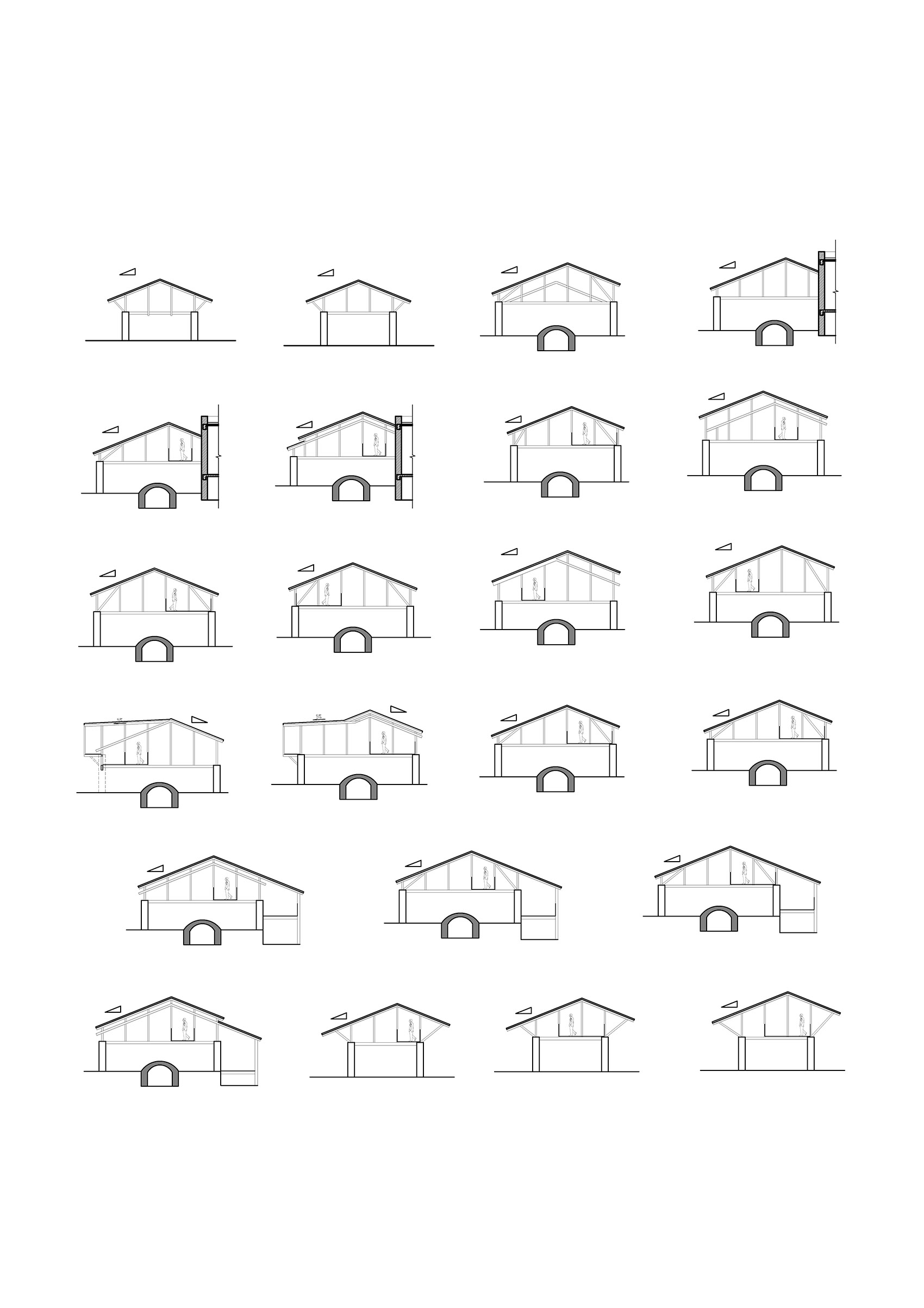
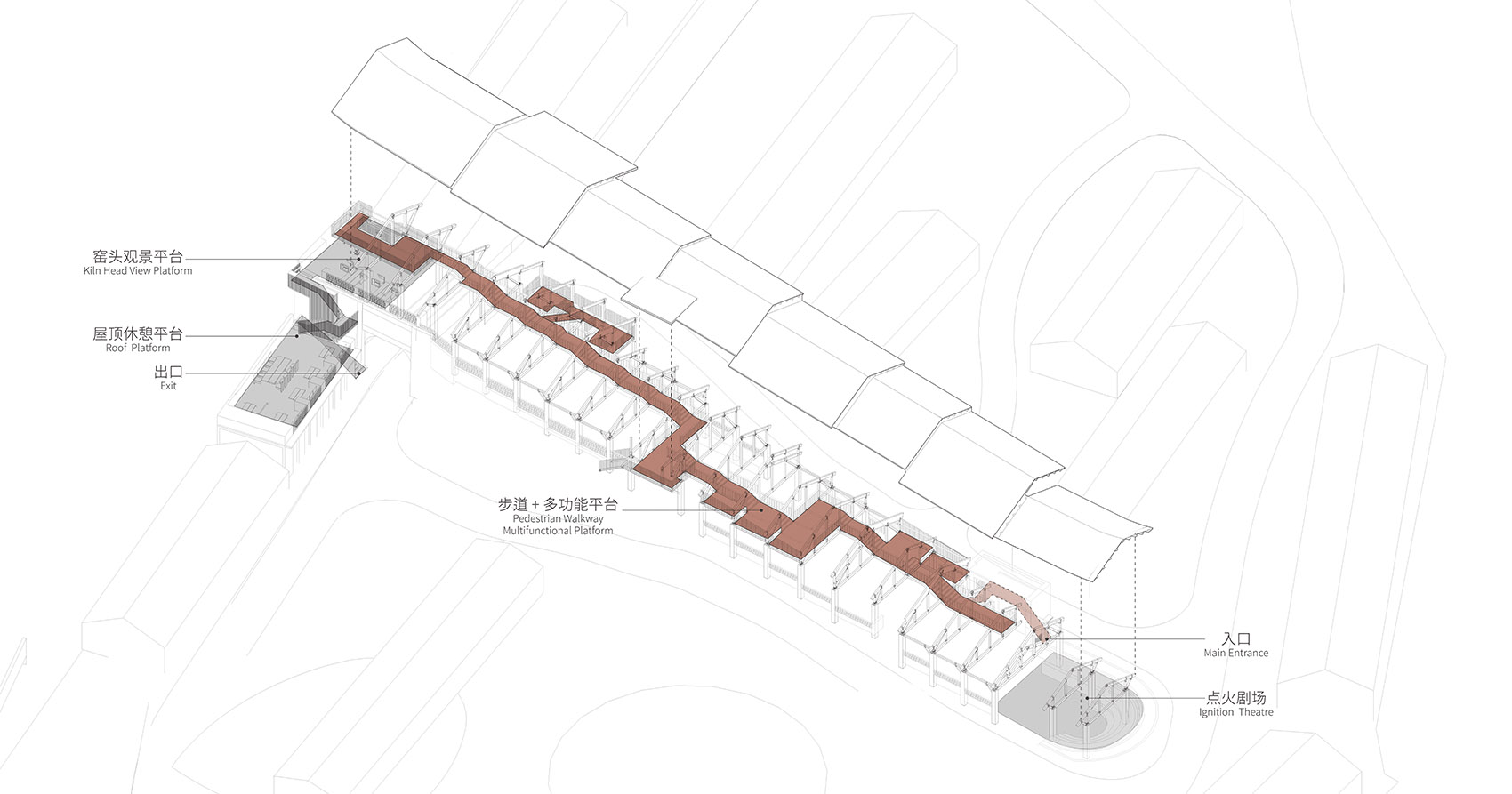
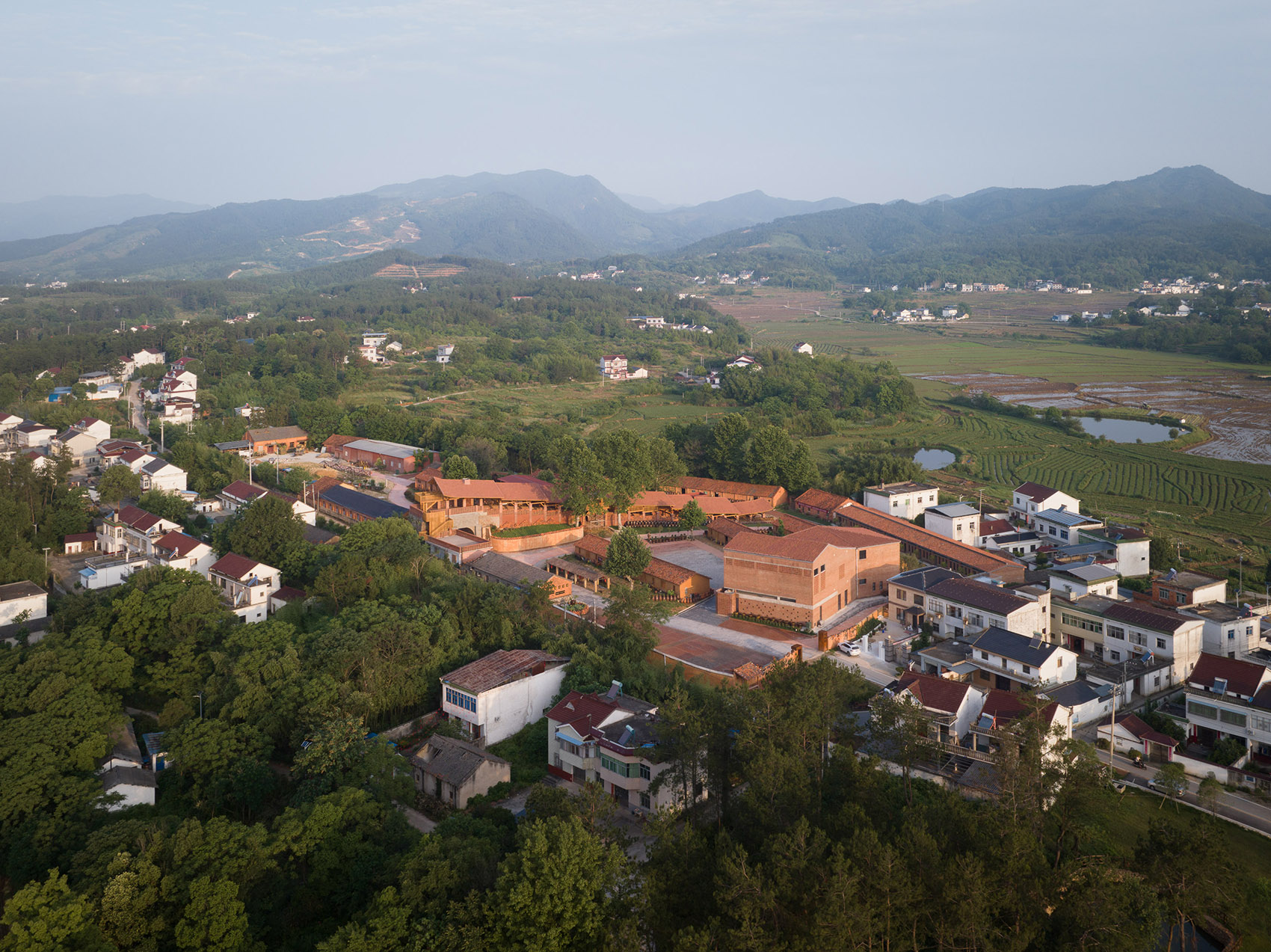
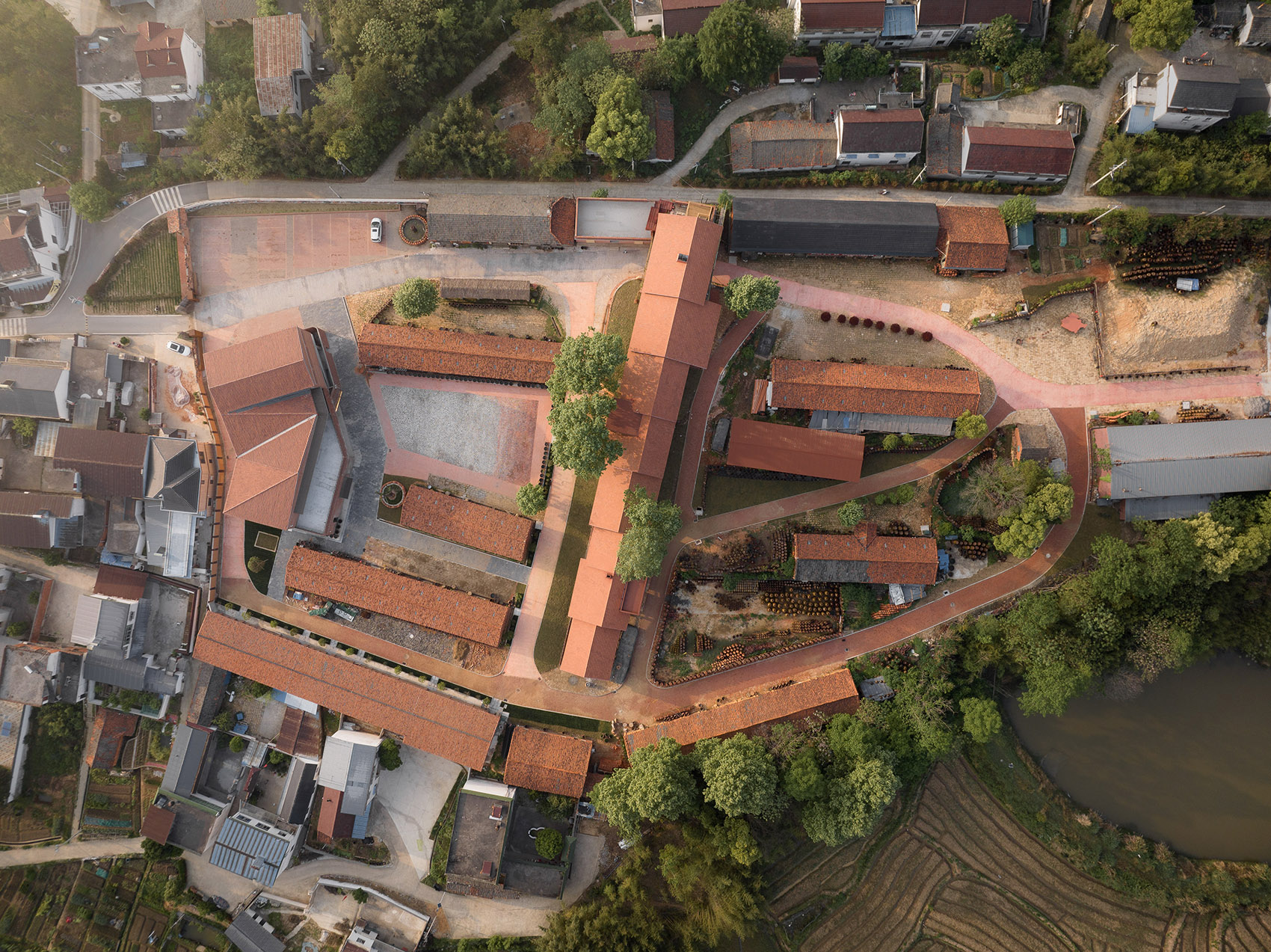
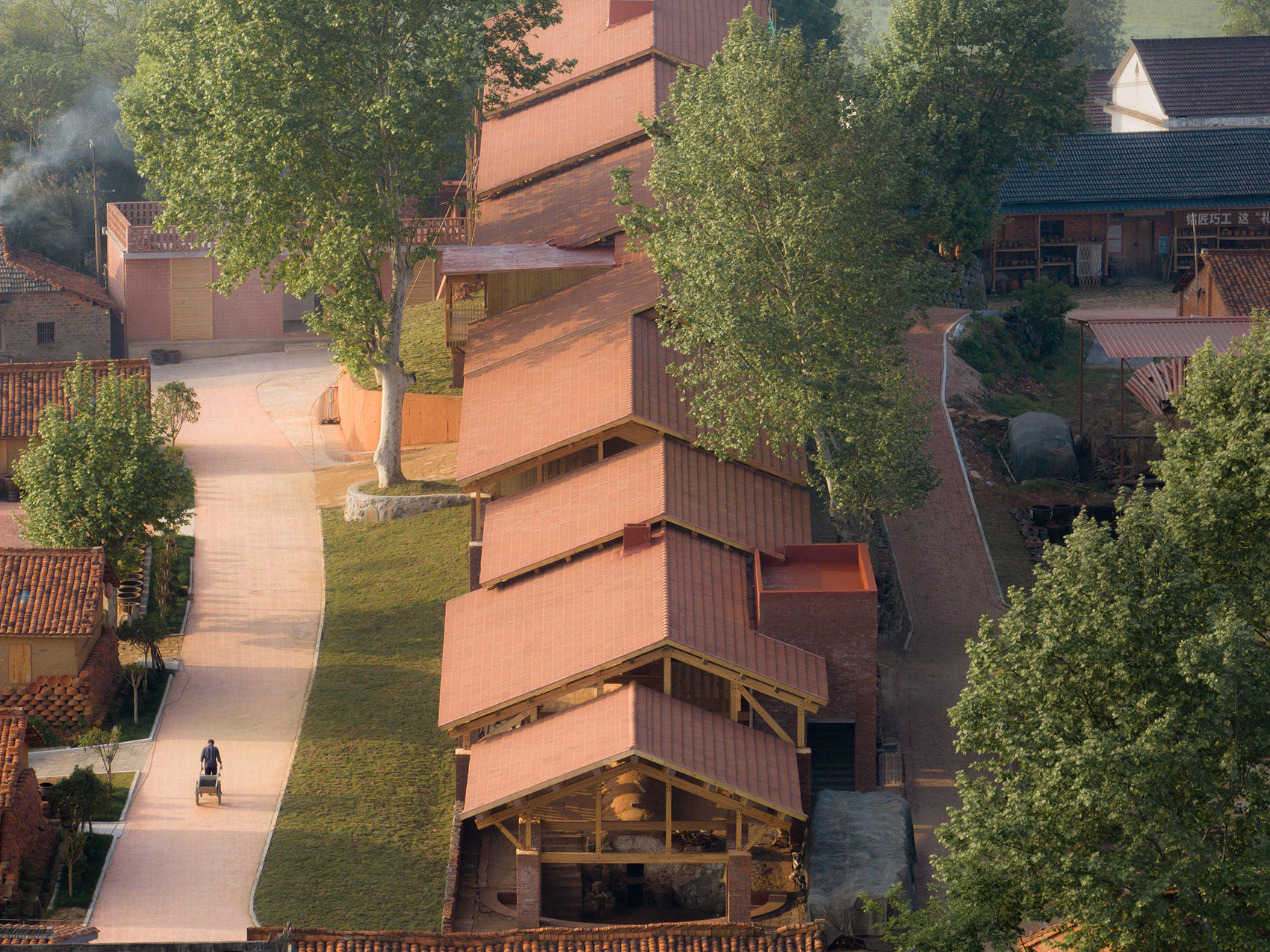
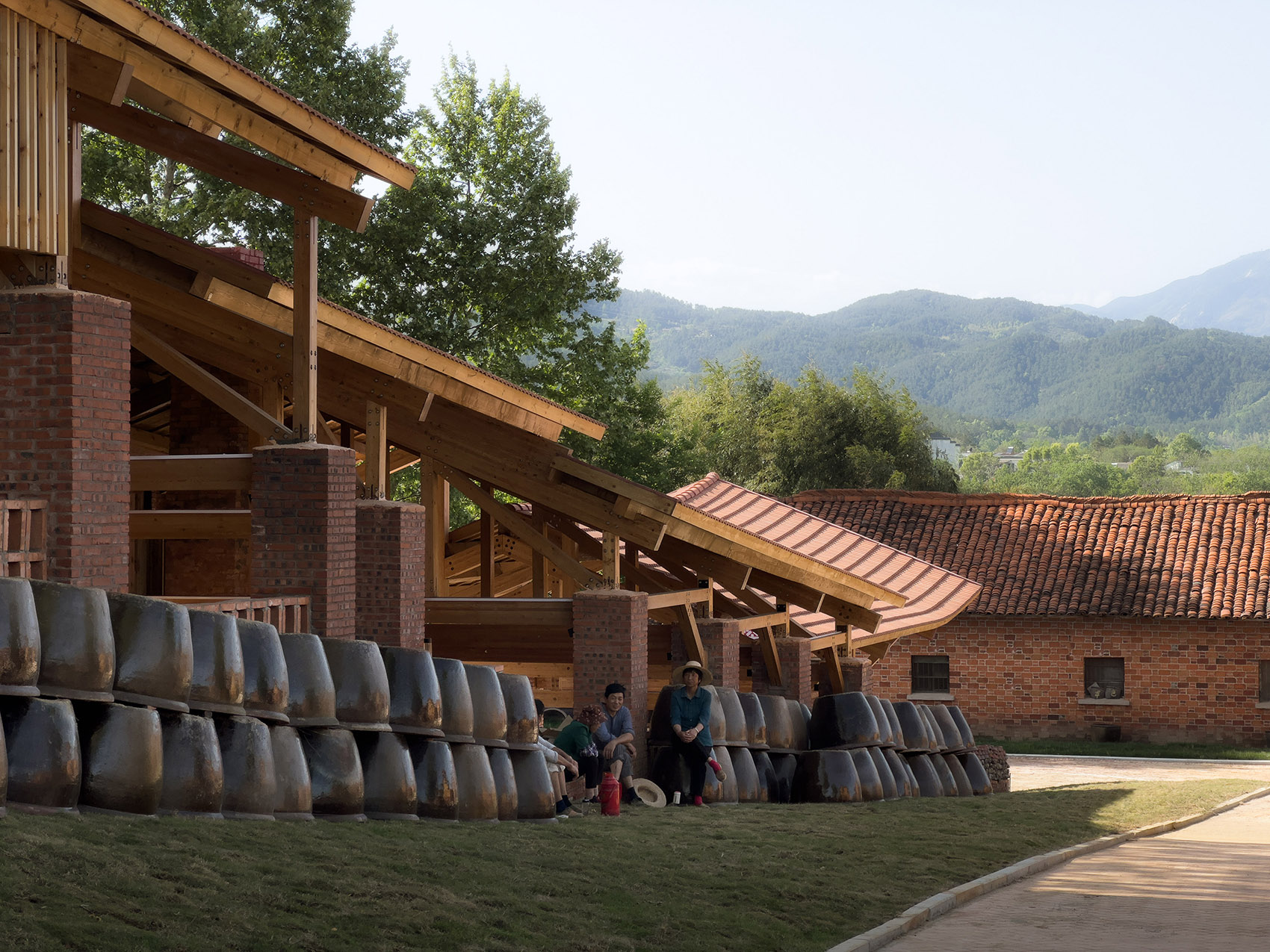
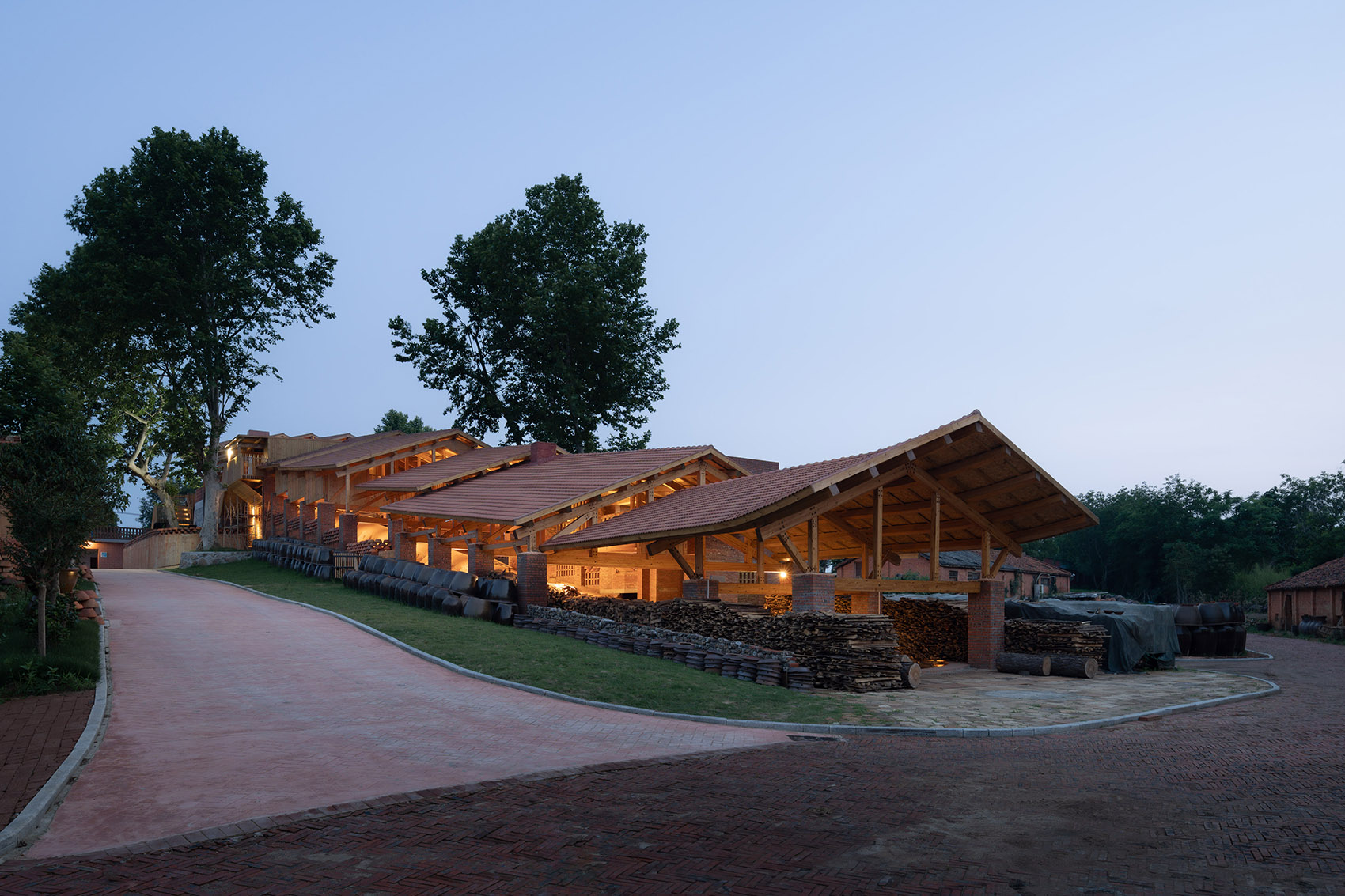

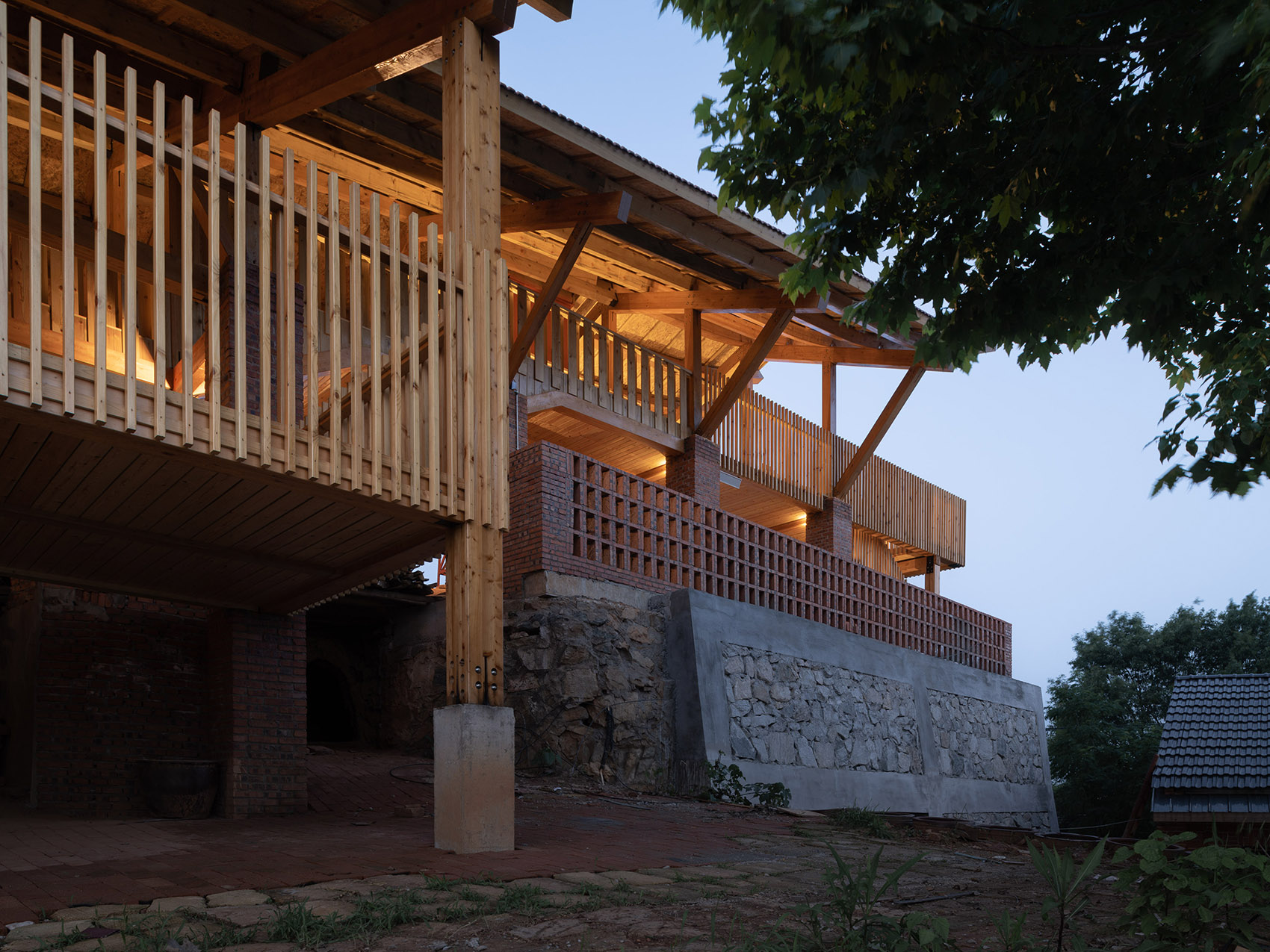
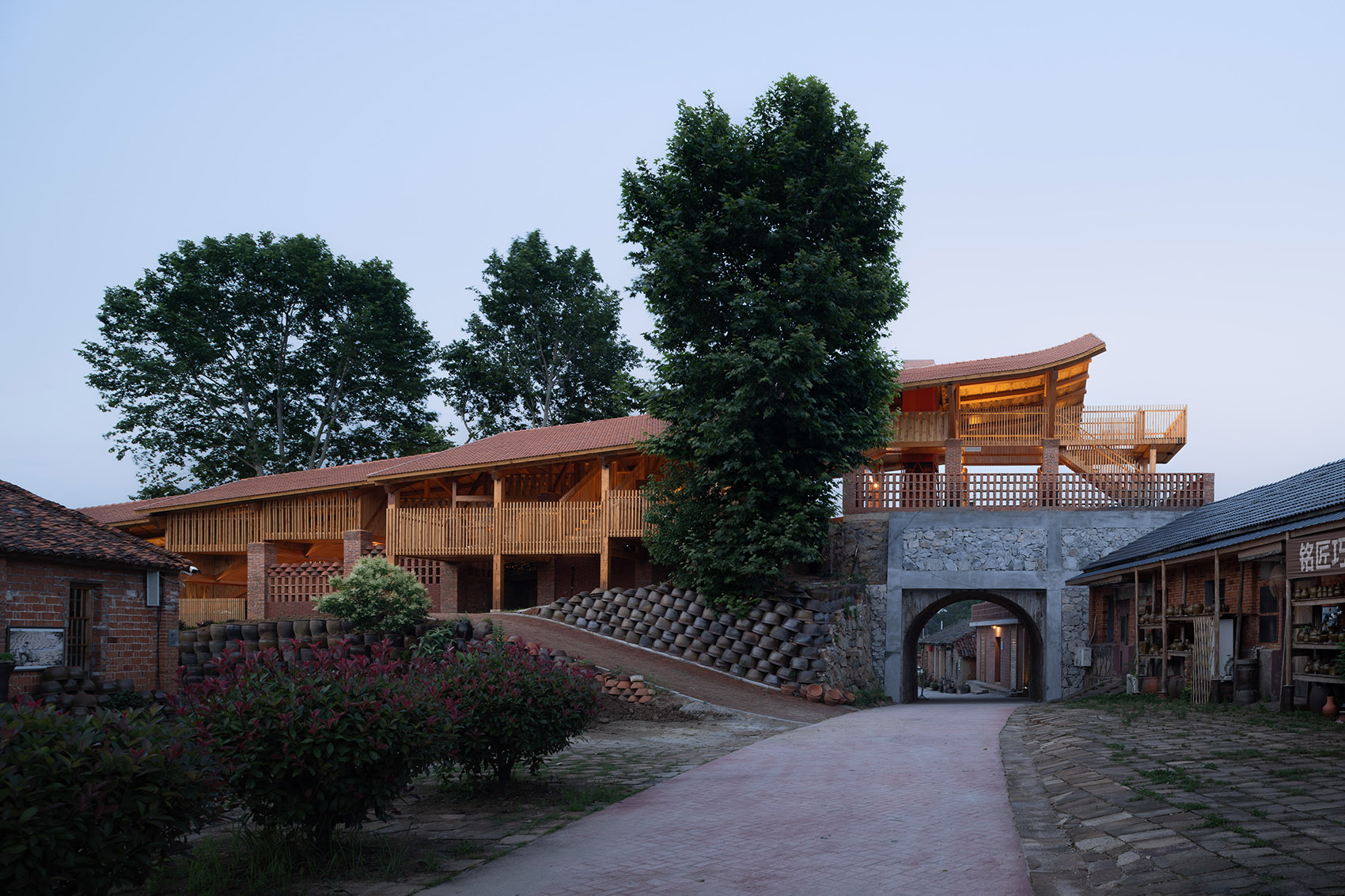


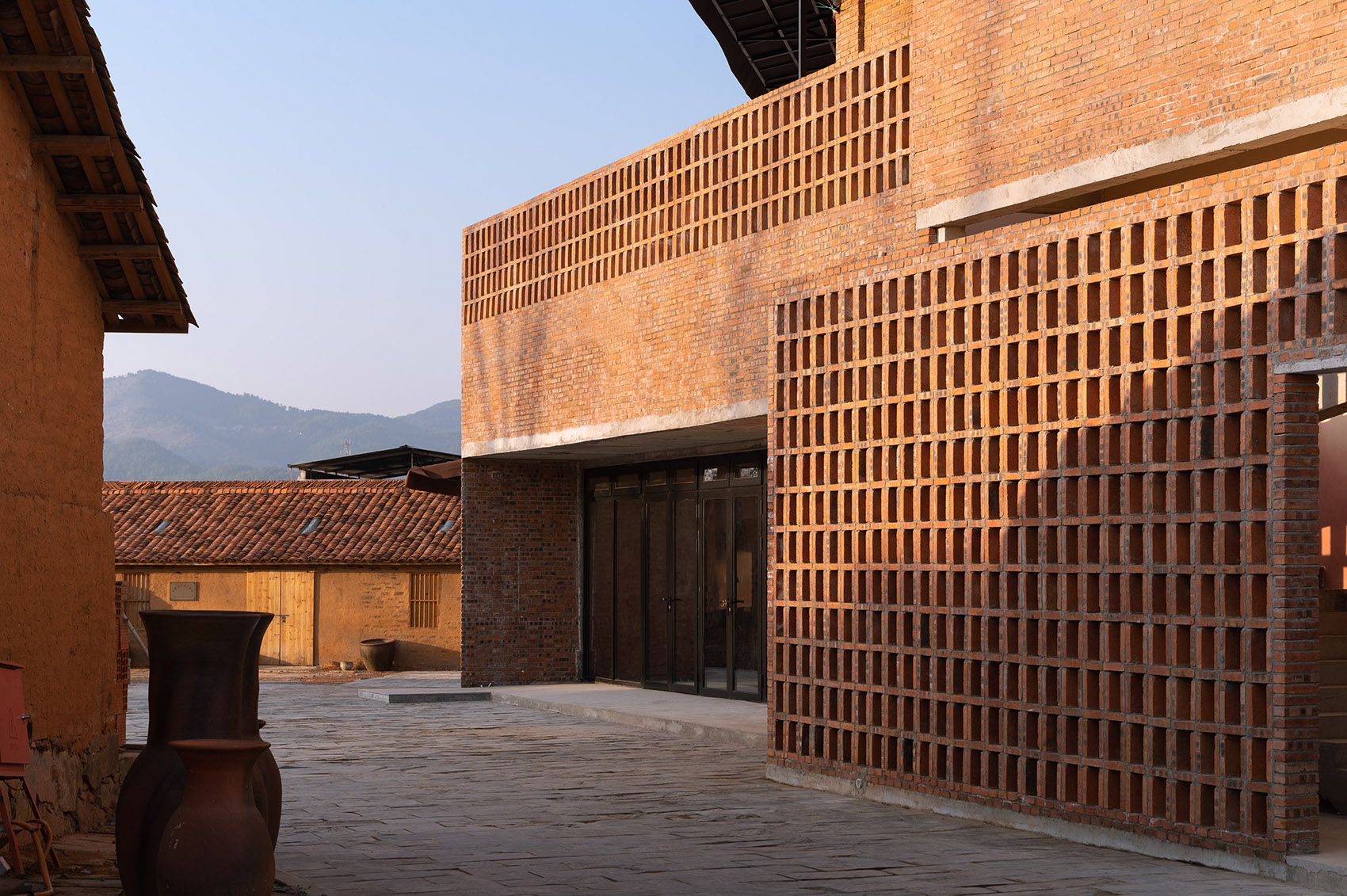

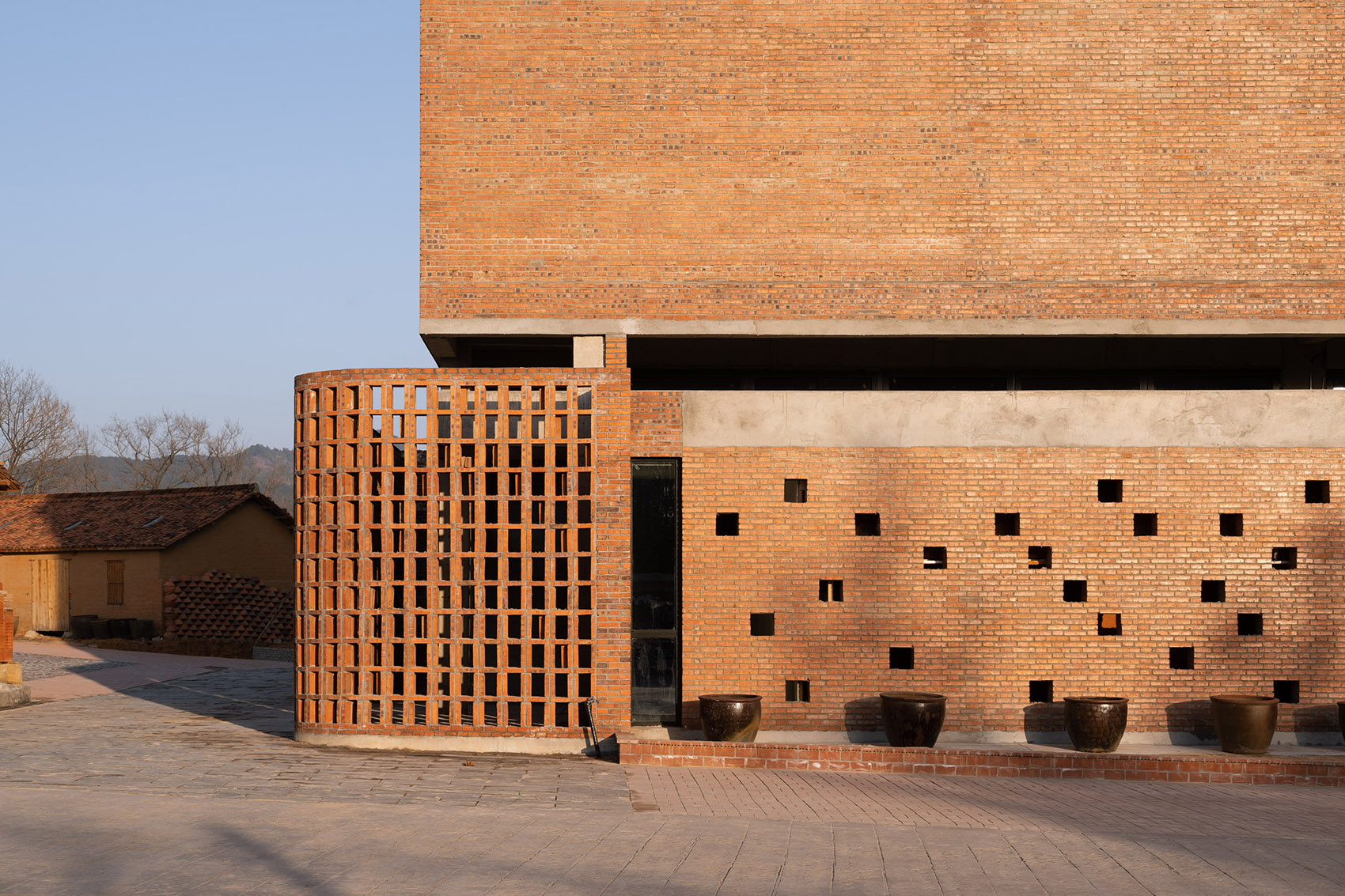
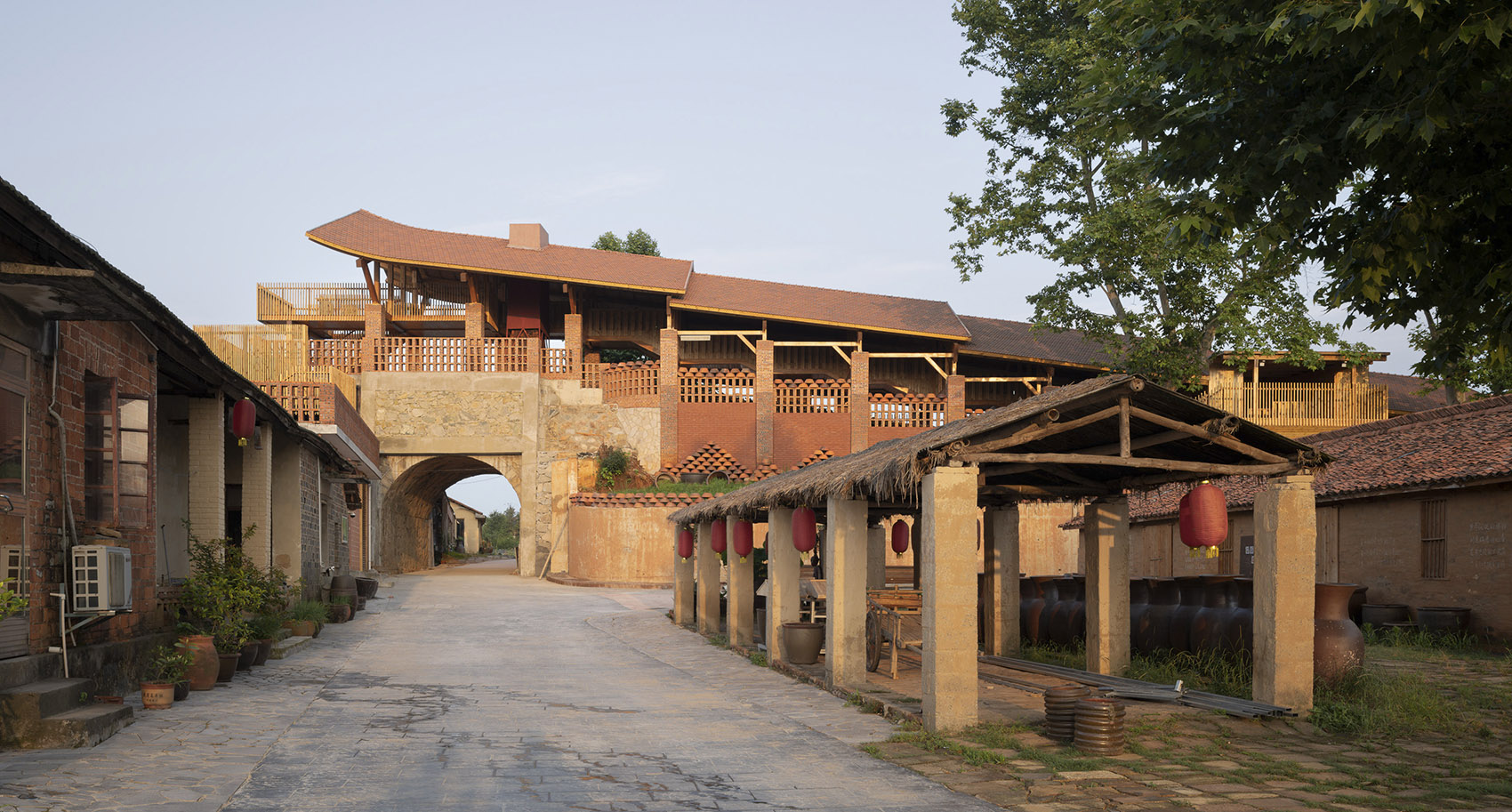
Grey space Architects :Two Buildings in the Pottery Factory: Roof Structure of the Dragon Kiln and ICH Lounge
At the end of 2021, when the architect was invited by the chief planner of the project, the founder of Sanbao International Ceramics Art Village, the Distinguished Professor of Jingdezhen Ceramic University, ceramicist LI Jianshen, to visit the site of Doumu Pottery, the factory has been undergoing a comprehensive upgrade. The design brief we have received consisted of the construction and renovation of two buildings: the ICH Lounge for which the foundation had already been excavated and therefore the location of the building outline and its structures had been determined; and the asbestos tile roofed dragon kiln, in urgent need of renewal to satisfy the requirements of soundness and aesthetics for a roof structure and to accommodate new functions as well.
痘姆制陶的历史可追溯到6000年前的薛家岗文化并绵延至今,其陶瓷烧制的技艺在当下也已被列入国家级非物质文化遗产代表性项目名录。如何保留传统的记忆并展示非遗的技艺,窑厂内的非遗客厅方案调整以及龙窑窑篷更新的设计任务,分别为建筑师提供了不同的挑战。
The history of pottery making at Doumu dates back to the Xuejiagang culture 6,000 years ago and continues to this day. Its artistry of firing ceramics has now been listed as national intangible cultural heritage. The adaptation of ICH Lounge in the kiln factory and the renovation of the dragon kiln roof structure, have respectively provided the architect with different challenges, in the way of preserving the traditional memory as well as showcasing the technique of the intangible cultural heritage.
在保证原设计主体建筑轮廓不变的前提下,建筑师对非遗客厅的建筑体块关系进行了调整,形成更丰富的底层空间界面及更亲人的尺度。建筑内部则通过流线梳理,形成一条完整的室内外结合的参观路径。
With the main building outline of the original design unchanged, the architect has adjusted the relationship of building massing for ICH Lounge, to create a richer spatial interface on the ground floor, in a more approachable scale. The interior of the building has been streamlined to form a complete indoor-outdoor visiting path.
龙窑窑篷设计则是在现有龙窑基础上,重新设计一个能遮风挡雨,满足下方烧窑需求的窑篷,同时在不影响烧窑作业的高处增加一条参观路径,形成一组全新的观察龙窑烧窑的视角。
The design of the dragon kiln roof structure reconstructed a canopy on the foundation of the existing kiln, to protect it against wind and rain as well as to meet the firing needs below. Meanwhile, a visiting path was to be paved at a higher level that would not interfere with the firing operation, allowing a brand new set of viewpoints to observe the firing of the dragon kiln.
参观路径——在窑背上东张西望 Visiting Path: Looking around on the Back of the Kiln
现存龙窑建造的历史可追溯至清朝,在漫长的历史岁月中,其经历过多次火灾烧毁及修复的过程。改造前的窑篷采用轻质耐烧的石棉瓦也是出于方便修复及防火的原因。支撑棚架的砖垛间距则是根据窑工添柴、放置陶坯的作业方式,综合考虑避让窑门、烟囱的位置,而最终确定其模数。因此新的设计基本保留原有的砖垛间距和结构形式,以保证传统烧窑方式不被干扰。
The existing dragon kiln was first built at the time of the Qing dynasty and has undergone many fires and restorations over the course of its long history. Lightweight and fireproof asbestos tile was adopted for the original roof out of its fire-resistance and ease of restoration. The module of spacing between the brick pillars that support the roof was finally determined according to the way the kiln workers adding firewood and placing greenware, taking into account the location of the kiln door and chimney. Thus the new design mainly retains the original spacing and structure of the brick pillars to ensure the traditional firing method is not disturbed.
龙窑屋架的既有形式是当地最普通的人字形松木木构屋架,每一榀三角形的构架均由下方的两组砖垛支撑。
The roof frame of the dragon kiln is in the existing form of herringbone pine timber frame, most commonly found in the area, with each triangle-shaped frame supported by two brick pillars below.
如何维持原有屋架的基本构型,再置入一组参观流线,便是龙窑改造所需解决的关键问题。建筑师在新建屋架的设计中尝试了不同的标准跨构建形式,最终被选定的方案在保留了原有屋架的构型的前提下,增加了一条蜿蜒于龙窑之上的参观路径,同时最大限度地控制了新屋架的高度,使其仅在原有屋架的基础上增加了1.8m。
The key issue to be addressed in the renovation of the dragon kiln was to incorporate a visiting path while maintaining the basic configuration of the original roof frame. The architect has experimented with different forms of a standard span for the new roof frame, and the final chosen solution has added a visiting path winding upon the kiln, in the premise of retaining the shape of the original roof, while minimizing the height increase of the new frame, adding only 1.8m on the original.
从厂区其他关键视点向龙窑看去,新建屋架和原有屋架在天际线起伏趋势与窑篷高度上没有过于明显的差异。在陶厂内,龙窑仍然是控制天际线最重要的元素,但被控制过高度的新建屋架并没有让天际线产生过于突兀的感觉。
When viewed from other key viewpoints of the factory towards the dragon kiln, there is no overly significant difference between the new and original roof frame, in terms of the undulation pattern of its skyline and the height of the roof. In the pottery factory, the kiln remains the most important element in controlling the skyline, but the newly built roof frame, in the controlled height, does not overpower the skyline.
场景叙事——并置、观察、对话 Scene Narrative: Juxtaposition, Observation, Dialogue
在龙窑窑背及内部工作的窑工与在屋架上穿行的游客,借新的屋架形式形成两组在空间中并行的流线。二者在视线上有多处交叉互看的位置,因安全生产的需要,二者之间未设计有相互连接的平台。
The kiln workers working on the back of and inside the kiln, together with the visitors walking on the roof walkway, form two parallel flows in the space on account of the new roof form. There are multiple cross-viewing points between the two, but for safety reasons no interconnecting platform has been designed between them.
参观者从窑尾的小剧场旁的砖砌小屋内拾级而上,经过两道转折后,东张西望地穿行于窑背上方。或东或西的参观流线位置是综合考虑外部建筑高度以及内部视线关系而确定的。
Visitors may walk up the stairs in the brick hut next to the small theatre at the kiln tail, through two turns, then looking around while walking through upon the back of the kiln. The position of the visiting path, on either east or west, is decided after comprehensive consideration of external building height and internal sight relationship.
每一处流线的转折和空间节点处的放大均是以龙窑午门位置作为参照而确定的。在中段的大午门处设置了可以俯瞰广场及远眺天柱山的平台节点,靠近龙头的小午门处则是设置了三段连续的平台以获得更完整的观看视角。龙头流线终点处设置的户外茶室提供了观看园区和天柱山的另一处视角。
目前完工的通道仅展现了参观人群通行、游览及观看烧窑的场景,未来将有更多的内容——诸如陶器展廊、长桌宴、时尚秀场等被置入于此。
Every turn in the flow and the enlargement of the spatial nodes are determined in refer to the locations of the noon gates of the dragon kiln. A platform overlooking the plaza and Tianzhu Mountain is set up at the large noon gate in the middle, while at the small noon gate near the dragon head provide three successive platforms, achieving a more complete view. An outdoor tea room at the end of the flow at the dragon head offers an alternative view of the factory and Tianzhu Mountain.
The currently completed walkway only showcases scenes of visitors passing through, sightseeing and appreciating the firing, while more activities are to be presented in the future, such as pottery exhibitions, long table banquet and fashion show.
记忆再现——材料形式的表达 Memory Recreated: Expression of Material Form
窑厂内随处可见的陶罐的堆砌方式、窑砖的表面肌理、龙窑内部的拱顶和分隔墙的砌筑方式均为设计师提供了丰富的素材与灵感,如何将其转译成为建筑语言并以当代的方式呈现,成为本项目的一项重要工作。
The way clay pots are piled up, the surface texture of the kiln bricks, the vault inside the kiln and the masonry of the partition walls seen everywhere in the factory all provide a wealth of material and inspiration for the designer, and it is an important task of the project to translate them into an architectural language and to present in a contemporary way.
非遗客厅与龙窑建筑功能与空间相互呼应,设计师在其中植入了几组“窑”主题的空间,如位于参观路径上的“窑之路”,国际展过厅的拱形空间,以及穹顶下的卫生间。这些空间与龙窑屋架一起完善了整个陶厂的参观路径。
ICH Lounge echoes the function and space of the dragon kiln, where the designer has placed several ‘kiln’-themed spaces, such as the ‘Road of Kiln’ on the visiting path, the vaulted space in the hallway of the international exhibition, and the toilet under the dome. Together with the dragon kiln roof structure, these spaces complete the visiting experience of the entire pottery factory.
结语 Afterword
在本项目中,建筑师尝试用适度的,能与场地较好融合的建筑形式和材料语言,以保护好非物质文化遗产和活着的千年龙窑为前提,为其融入当代的生活环境,承载更多的公共展示功能,接待更多的游客等提供更多的使用场景。
In this project, with the premises of preserving the intangible cultural heritage and the living millennial dragon kiln, the architect has attempted to use a modest architectural form and material language that are well adapted to the site, to provide more scenarios for its integration into the contemporary living environment, carrying more public display functions and accommodating more visitors.
项目名称:安徽潜山痘姆龙窑及非遗客厅设计
项目类型:建筑/室内设计
项目地点:安徽省潜山市痘姆乡
项目策划:景德镇朴缘文化传媒有限公司
联合出品:潜山市痘姆乡人民政府、景德镇三宝国际陶艺村李见深工作室
总策划、总设计:李见深
总执行:田伟伟
项目设计:灰空间建筑事务所
主持建筑师:刘漠烟、苏鹏
龙窑设计团队:应世蛟、雁森
非遗客厅设计团队:琚安琪、李园园、莫仙、陈凯琪
项目建筑师:雁森
结构顾问:iStructure
灯光顾问:扈靖
景观设计:翟隽
机电设计:芮文工程设计事务所
千年墙及大门:涂锐、谢斐、刘华辉等
非遗客厅布展平面设计:郭玉川、魏文卿、宋贤茂、胡奕胜
施工图设计:上海开艺建筑设计有限公司
摄影:柯剑波
英文版译者:杨潇晗
建成状态:建成
设计时间:2021年12月-2022年6月
建设时间:2022年5月-2023年5月
建筑面积:2150㎡
Project Name: Doumu Dragon Kiln and ICH Lounge in Qianshan, Anhui
Project Type: Architecture / Interior
Project Site: Doumu Township, Qianshan City, Anhui Province
Project planner: Jingdezhen Puyuan Culture Media Co., LTD
Co-producer: Qianshan Doumu Township People’s government, LI Jianshen Studio of Jingdezhen Sanbao International Ceramics Art Village
General planning and design: Li Jianshen
Chief Executive: Tian Weiwei
Design Team:Greyspace Architects
Principal Architect: LIU Moyan, SU Peng
Dragon Kiln Design Team: YING Shijiao, YAN Sen
ICH Lounge Design Team: JU Anqi, LI Yuanyuan, MO Xian, CHEN Kaiqi
Project Architect: YAN Sen
Structural Consultant: YANG Xiaotian and PENG Chao from iStructure
Lighting Consultant:HU Jing
Landscape Design: ZHAI Jun
Mechanical Electrical Engineering Design: Ruiwen Design Studio
Closure and gate design: TU Rui、XIE Fei
Exhibition design of ICH Lounge: GUO Yuchuan、WEI Wenqing、SONG Xianmao、HU yisheng
Construction Design:Kaiyi Architectural Design Co., Ltd
Photography: KE Jianbo
English version translated by YANG Xiaohan
Status: Built
Design Period: December 2021 – June 2022
Construction Period: May 2022 – May 2023
Built Area: 2,150 m²